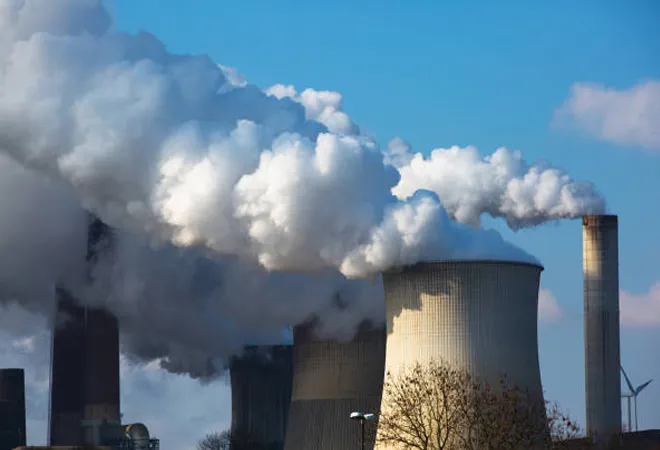
India’s commitment to its 2070 net-zero target entails that it must explore all potential interventions and leverage them to their fullest. Here, nature-based solutions like blue carbon ecosystems e.g., mangroves, tidal and salt marshes, seagrasses, etc. can be crucial for carbon sequestration. However, India's ‘Long-Term Low-Carbon Development Strategy’ document submitted to the United Nations Framework Convention on Climate Change (UNFCCC) is not focusing on this opportunity. The absence of a clear pathway for the restoration of blue carbon storage assets can be a major source of carbon emissions in the future.
Climate change mitigation and adaptation benefits
India is blessed with a 7,500+ kilometre-long coastline. As per Anirban Akhand et. al. (2022), India could presently have about 5,000 sq. km of mangroves, 500 sq. km of seagrasses, and anywhere between 300 to 1400 sq. km of salt marshes which cumulatively adds up to about 0.5 percent of the country’s total area. Despite their small expanse, these coastal systems can sequester carbon considerably faster and for millions of years. According to Hamilton and Friess (2018)
<1>, they can capture carbon dioxide (CO
2) up to 20 times greater than any other terrestrial ecosystem, including boreal and tropical forests. Presently, their total carbon sequestration potential has been estimated as 702.42 million tons of CO
2e about 22 percent of India’s annual carbon emission. It has also been estimated that there is an additional sequestration potential of 207.91 million tonnes of CO
2e if the mangrove cover is conserved and protected.
Coastal ecosystems provide climate adaptation benefits such as protection from hurricanes and sea-level rise, prevention of shoreline erosion, and regulation of coastal water quality.
Additionally, coastal ecosystems provide climate adaptation benefits such as protection from hurricanes and sea-level rise, prevention of shoreline erosion, and regulation of coastal water quality. Moreover, restoring coastal areas offer several ecosystem services such as food security, livelihoods (small-scale fisheries), and biodiversity.
Unfortunately, coastal ecosystems are eroding due to urbanisation, the conversion of land into agriculture and aquaculture, and extreme weather events. The ‘Nature’ journal mentions India as a ‘blue carbon wealth recipient country’ instead of a blue carbon ‘donor’ country. This suggests an underutilisation of blue carbon resources in India.
India needs to give impetus to blue carbon
The lack of focus on blue carbon in its low-carbon strategy implies India must bring about a ‘sea change’ in its understanding of its coastal ecosystems as a strategic carbon sequestration reserve. Saying that India has turned a blind eye toward these possibilities is not an overstatement. It may so happen that some of India’s previous activities under its afforestation and reforestation initiatives include minor aspects of the restoration and rejuvenation of coastal ecosystems. However, with changing times it is imperative to earmark and unify such projects under the broader umbrella of ‘blue-carbon’ to keep up with the evolving nature of global climate policy.
Time for a National Institute for Blue-carbon
The Government of India should realize that the country has so far relied only on homogenous literature on blue carbon, often by very few subject matter experts. It should now step in to create, compile, and formalise these databases towards institutionalising this workstream.
The lack of focus on blue carbon in its low-carbon strategy implies India must bring about a ‘sea change’ in its understanding of its coastal ecosystems as a strategic carbon sequestration reserve.
To help itself emerge as a leader in the blue-carbon sector, India must draw inspiration from specialised peer organisations like the National Institute of Wind Energy (NIWE), National Institute of Solar Energy (NISE), National Institute of Bioenergy (NIBE) etc. set up an organisation for the blue-carbon sector. This new institute can collaborate closely with the Indian Meteorological Department, National Institute of Oceanography, National Botanical Research Institute, ISRO, IIT Bombay’s National Center of Excellence in Carbon Capture and Utilization, etc. to fulfil the necessary conditions needed to catalyse this sector. It can promote the establishment of requisite standards, codes, and peer-review frameworks for assessing blue carbon solutions. It can also harbour human resource skilling activities, incubate start-ups, and promote innovation clusters that prevent the degradation of coastal ecosystems, retain soil nutrition and conserve indigenous biodiversity while respecting the cultures and aspirations of local communities.
National mission for blue carbon
To streamline the technological developments with financial and policy interventions in the blue-carbon sector, it is important that the GOI launches a strategic mission for the same. It can decide national targets for relevant sectors that contribute towards the development of a blue-carbon ecosystem and subsequently define the phase-wise strategies for value-chain development for acquiring knowledge, manpower, money, and materials that can stimulate the country’s collective efforts. It can identify the potential demand generation actions like blue carbon obligations while pushing to put in place the key enablers for domestic and international players in this space. Setting up a robust carbon market in the country can be a critical element of this journey. It can launch pilot projects with the private sector/NGOs/Think Tanks while ensuring appropriate monitoring, compliance, and risk-mitigation guidelines. According to a McKinsey, blue carbon nature-based systems like peatland restoration can be achieved at a price of US$50/tCO2 equivalent by the year 2050 in India. It also proposes that emerging blue-carbon solutions can compete with nature-based solutions of land. The proposed mission can be empirically validated through pilots and decide financial outlays for the short-to-medium terms to outperform market expectations. Subsequently, the experience can be shared globally.
To streamline the technological developments with financial and policy interventions in the blue-carbon sector, it is important that the GOI launches a strategic mission for the same.
International partnerships
Due to its geostrategic location, India can be a leading beacon to synchronize cross-functional and cross-continental efforts in the blue carbon space. It can forge meaningful consensus across bilateral and multilateral forums. Also, for its own interests, it must actively participate in platforms like the Blue Carbon Initiative, International Partnership for Blue Carbon, and various upcoming projects related to nurturing blue forests in the Indian ocean. India’s recent support of the French-led ‘High Ambition Coalition on Biodiversity Beyond National Jurisdiction’ and its participation in the ‘One Ocean Summit’ are early steps in the right direction. India can also support Small Island Developing States (SIDS) on their vast blue carbon resources. The lack of India’s thought leadership on this front has led to disappointment amongst such countries in the climate dialogues. As India has recently taken over the presidency of the G20, it can summon its capabilities to fill in this void.
The water bodies surrounding India have deeply influenced its civilizational evolution. Its ancient ethos, literature and manuscripts have always venerated the gifts received from the high seas. India’s ambitions to emerge as a climate leader warrants, its rise as a leader in the blue-carbon arena.
References:
<1>
https://link.springer.com/article/10.1007/s11625-022-01181-4
<2>
https://www.nature.com/articles/s41558-021-01089-4
<3>
https://www.iucn.org/resources/issues-brief/blue-carbon
The views expressed above belong to the author(s). ORF research and analyses now available on Telegram! Click here to access our curated content — blogs, longforms and interviews.



 India’s commitment to its 2070 net-zero target entails that it must explore all potential interventions and leverage them to their fullest. Here, nature-based solutions like blue carbon ecosystems e.g., mangroves, tidal and salt marshes, seagrasses, etc. can be crucial for carbon sequestration. However, India's ‘Long-Term Low-Carbon Development Strategy’ document submitted to the United Nations Framework Convention on Climate Change (UNFCCC) is not focusing on this opportunity. The absence of a clear pathway for the restoration of blue carbon storage assets can be a major source of carbon emissions in the future.
India’s commitment to its 2070 net-zero target entails that it must explore all potential interventions and leverage them to their fullest. Here, nature-based solutions like blue carbon ecosystems e.g., mangroves, tidal and salt marshes, seagrasses, etc. can be crucial for carbon sequestration. However, India's ‘Long-Term Low-Carbon Development Strategy’ document submitted to the United Nations Framework Convention on Climate Change (UNFCCC) is not focusing on this opportunity. The absence of a clear pathway for the restoration of blue carbon storage assets can be a major source of carbon emissions in the future.
 PREV
PREV



